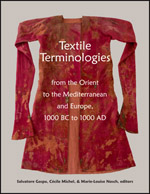Center, Textile Research

Textile Terminologies from the Orient to the Mediterranean and Europe, 1000 BC to 1000 AD
Date of this Version
2017
Document Type
Article
Citation
In Textile Terminologies from the Orient to the Mediterranean and Europe, 1000 BC to 1000 AD, ed. Salvatore Gaspa, Cécile Michel, & Marie-Louise Nosch (Lincoln, NE: Zea Books, 2017), pp. 421-436.
doi:10.13014/K2154F74
Abstract
In an analysis of the household-management (οἰκο- νομία) in the first book of the Politics, Aristotle discusses the nature and use of tools (ὄργανα), both inanimate (τὰ ἄψυχα) and animate (τὰ ἔμψυχα). While such a distinction is functional, in Aristotle’s argument, to illustrate the priority of the latter group (represented by the assistant, ὁ ὑπηρετής, and the slave, ὁ δοῦλος) over the first, what interests us here lies mainly within the realm of inanimate tools. As commentators to the passage have not failed to notice, a first literary frame of reference for Aristotle’s exemplum fictum is to be found in the conflation of two motifs: the myth of selfmoving (ἀυτόματα) artefacts created by divine or divinely- gifted craftsmen (Hephaestus’ wheeled tripods and Daedalus’ statues), and the Old Comedy utopia of a golden age when no slaves were needed, as household utensils would move and perform their task by themselves. In addition to that, however, a further underlying element that joins together the τέχναι (crafts) alluded to in the Politics passage can be detected in the relationship these entertain with the concept (cum technology) of weaving, reflected at the level of poetic imagery by patterns of textile terminology. This may seem pretty obvious in the case of the verb κερκίζειν, i.e. the action of beating the weft threads into place by means of a weft-beater (κερκίς). As a fundamental principle in the mechanics of weaving on the vertical warp-weighted loom, striking the threads with a κερκίς had a distinctive visual and acoustic dimension: it was one of the most typical gestures of the weaver, and, more important, it seems to have produced a recognizable rhythmic sound. Both these features explain, to a certain degree, why in a number of literary as well as iconographic sources the technique of striking the strings of a lyra or kithara with a plectrum (κι- θαρίζειν is the verb used in Politics 1254a1) is assimilated to the act of hitting and strumming threads on a loom with a weft-beater. Aristotle’s juxtaposition of κερκίδες and plectra is a case in point: while the focus is kept on the similar function performed by the two objects in the realm of their respective (and thus comparable) τέχναι, the passage may, if only indirectly, reflect the long-standing association in ancient Greek musical imagery between the craft of weaving and the craft of playing (mainly stringed) instruments.
Included in
Ancient History, Greek and Roman through Late Antiquity Commons, Art and Materials Conservation Commons, Classical Archaeology and Art History Commons, Classical Literature and Philology Commons, Fiber, Textile, and Weaving Arts Commons, Indo-European Linguistics and Philology Commons, Jewish Studies Commons, Museum Studies Commons, Near Eastern Languages and Societies Commons, Other History of Art, Architecture, and Archaeology Commons


Comments
Copyright © 2017 Salvatore Gaspa, Cécile Michel, & Marie-Louise Nosch. Photographs copyright as noted.
The research for this publication has received funding from the European Research Council (ERC) under the European Union’s Horizon 2020 research and innovation programme (grant agreement No. [682711 PENELOPE]